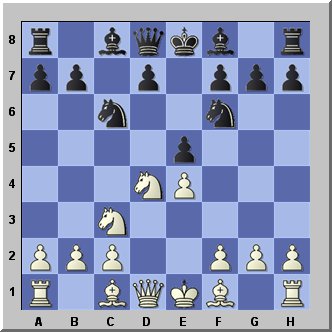There are endless number of possible variations in chess, even after just a few moves have been played. That said, some chess openings are time-tested and popular. Recognizing and understanding the basics of these openings will increase your confidence in the opening phase of the game.
Ruy Lopez
The Ruy Lopez (also known as Spanish Game) is named after the Spanish priest who analyzed this opening in 1561. Nearly half a millennium later, the Ruy Lopez is now one of the most popular chess openings at all levels. Numerous variations have been deeply studied, and a wide variety of strategic plans are available to both White and Black.
The starting position of Ruy Lopez is reached after 1. e4 e5 2. Nf3 Nc6 3. Bb5
Popular lines in Ruy Lopez include - but are certainly not limited to - the Morphy Defense, the Steinitz Defense and the Berlin Defense. Each of these and several other popular variations leads to numerous sub-variations.
Italian Game
First developed in the 1600s and perhaps the oldest of chess openings, the Italian Game is reached by the moves 1. e4 e5 2. Nf3 Nc6 3. Bc4. It remained quite popular through the 19th century, but today has been supplanted by Ruy Lopez as White's favorite choice on the third move. Bc4 eyes Black's potentially weak f7 pawn, but improved defensive technique has shown this to be less dangerous to Black than Bb5. Still, the Italian Game often leads to aggressive, open positions which can be fun to play. This opening is still seen at all levels - and is quite popular among club players.
Popular variations in Italian Game include the Giuoco Piano, the Two Knights Defense and the Hungarian Defense.
Sicilian Defense
The Sicilian Defense (1. e4 c5) is currently Black's most popular response to e4, especially at the highest levels of chess. By playing c5, Black immediately fights for the center and attacks d4, but avoids the symmetry of e5. The Sicilian Defense typically leads to a complex and dangerous struggle where both sides can play for a win.
There are many distinct variations in the Sicilian Defense , each of which lead to different types of positions; some of the most popular include the Closed Sicilian, the Classical Sicilian, the Dragon Variation and the Najdorf Variation.
French Defense
The French Defense (1. e4 e6) concedes central space to White and limits the scope of his king's bishop, but prevents tactics against f7 while allowing Black to have activity on the queenside and counterplay in center.
After the most typical line of 2. d4 d5, White's e-pawn is immediately pressured, and White must decide how to deal with this - leading to several popular variations. Some of the most common include the Exchange Variation, the Advance Variation, the Tarrasch Variation, the Winawer Variation and the Classical Variation.
Caro-Kann Defense
Like the French Defense, the Caro-Kann Defense (1. e4 c6) prepares d5 on Black's second move to challenge White's e4 pawn. The Caro-Kann is extremely solid, but not as dynamic as many of Black's other defenses against e4. Compared to the French Defense, Black has avoided a source of counterplay in both defenses.
Popular variations in the Caro-Kann Defense include the Classical Variation, the Advance Variation, the Exchange Variation and Panov-Botvinnik Attack.
Pirc Defense
Originally seen as an inferior opening, the Pirc Defense (1. e4 d6) is today known as a solid choice. Black allows White to built an imposing center, then attempts to turn that center into a target for attack.
Some common variations in Pirc Defense include the Classical System and the Austrian Attack.
Queen's Gambit
White players who prefer a quieter, more positional game tend to prefer 1. d4 to 1. e4, after which the c4 break is the best way to play for an advantage (either on the second move or soon after). The Queen's Gambit, marked by the moves 1. d4 d5 2. c4, is one of the oldest known chess openings. This classical approach "offers" a pawn (in reality, Black cannot expect to hold onto the pawn if he chooses to capture it) in exchange for a stronger center.
Black has several options, including the Queen;s Gambit Accepted, the Queen's Gambit Declined and the Slav Defense.
Indian Defenses
After1. d4, Black is not obligated to play d5 in response. Today, the most popular response to d4 is Nf6, which leads to a collection of openings known as the Indian Defenses. These openings while less solid than the classical d5, offer more immediate opportunities for counterplay.
There are many popular lines arising after Nf6, including te King's Indian Defense, the Nimzo-Indian Defense, the Queen's Indian Defense and the Grunfeld Defense.
The English Opening is a flexible choice for White. The English Opening often transposes into openings normally seen after 1. d4, either exactly or with slight variations due to move order. It is also possible to enter a "reversed" Sicilian Defense if Black responds with e5, where White is playing the Sicilian with an extra tempo.
One well-known setup that can arise from the English Opening is the Hedgehog Defense.
Réti Opening
The Réti Opening (1. Nf3) is named after the great chess master Richard Réti . Like 1. d4 and 1. c4, the Réti also generelly leads to closed positions and all there moves can transpose into similar setups.
One possible formation for White is the King's Indian Attack.










No comments:
Post a Comment